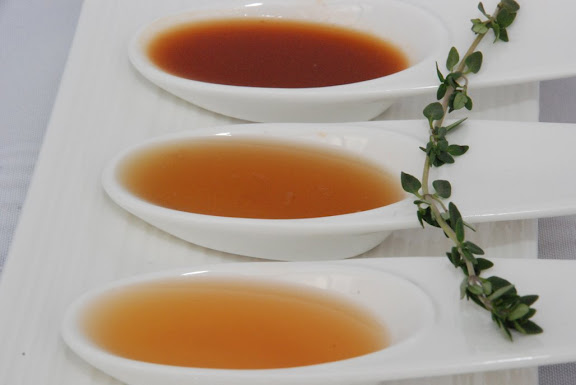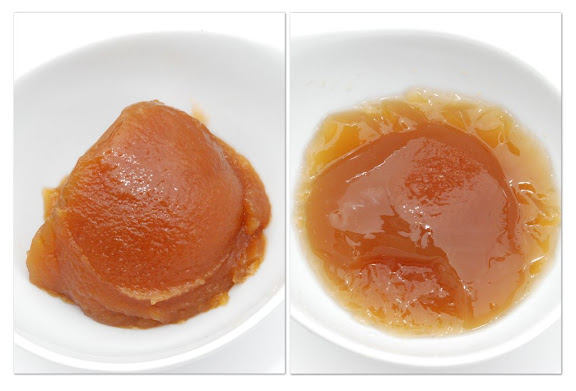 Stock, stock, and more stock. My refrigerator is overflowing with all sorts of stock. White stock from last week’s post, and this week I have a fridge full of variations on a brown stock theme.
Stock, stock, and more stock. My refrigerator is overflowing with all sorts of stock. White stock from last week’s post, and this week I have a fridge full of variations on a brown stock theme.Brown stock. Who knew how complicated this topic would be. First, there’s the issue of beef versus veal, which led to research about collagen, which led to research about umami. Then, there’s the question about whether to roast the meat beforehand or not, which introduces the differences between carmelization and the Maillard reaction. All brown stock is supposed to be roasted, isn’t it? Yet, I found some veal stocks that were presented more like white stocks, namely from that inventive, amazing chef named Thomas Keller (Best California Chef in 1996 and the Best Chef in America in 1997, famous for his restaurant The French Laundry). It was a little overwhelming for what seemed at first to be a simple topic.
To begin, I raided several butcheries of their treasured veal bones, or tried to. One butchery didn’t have any, another wasn’t willing to sell theirs, another charged me an arm and a leg for a bag o’ bones, and finally – jackpot – one gave me a bag for free. I’ll definitely be spending more time and money at that butchery in the future! And so, I made stock. In many variations. Beef, veal, roasted, not roasted, roasted with tomato paste, roasted without tomato paste, and finally the labor-intensive Thomas Keller way.“You can’t have a good sauce if you start with a bad stock.”
The French Laundry Cookbook

Click for larger image
Now I have 40+ cups of stock to freeze and use up in the coming weeks, months, years! And some that I will only use as a sauce base for the best cuts of meat, like pulling out a prized bottle of wine from a cellar.
“Indeed, stock is everything in cooking. Without it, nothing can be done. If one’s stock is good, what remains of the work is easy; if, on the other hand, it is bad or merely mediocre, it is quite hopeless to expect anything approaching a satisfactory meal.”
Auguste Escoffier in Guide Culinaire (1903)
Bovine collagen
You can make brown stock from chicken, beef, or veal. Since I tried chicken stock last week, I wanted to try brown stock made with beef and veal.
As I learned last week, stock is the most important flavor carrier for soups and sauces. But I didn’t know that the magic ingredient in stock is collagen.

Collagen is a protein in animals that connects and supports bodily tissues, such as skin, bone, tendons, muscles, and cartilage. While the collagen from the bones cooks, it dissolves into gelatin, picks up the flavors from the bones and aromatic vegetables, and transfers them into the stock. As the stock simmers, it’s collecting healthy minerals from the bones like calcium, magnesium, phosphorus, silicon, sulphur, and trace minerals. Good stock builds strong bones, relieves sore throats, and helps the sick. The resulting gelatin is the ‘glue’ that combines all the flavors and gives body to the soup or sauce.
More collagen is found in a younger animal. As an animal gets older, it makes less collagen. Also, more collagen is in the knuckles and joints of these animals. Finally, more collagen is found in veal than in beef. So, at the butchery, ask for the knuckles and joints of a young veal (if you can get over the morality of it all, that is, and your butcher is willing to part with this soon to be liquid gold).
Veal stock‑a magic elixir
So, one reason veal stock is a miraculous substance is due to the extra collagen you get from the bones. Now, what is it about all this collagen that makes it so desirable in stock? Why do we want it to wibble and wabble like Jell-O after simmering it all day? One reason is that this gelatin naturally and easily thickens and enriches the soup or sauce in which the stock is used, providing richness and mouthfeel. It’s all about taste.
“Auguste Escoffier invented veal stock.” So begins Jonah Lehrer’s essay on “The Essence of Taste” in his book called Proust Was a Neuroscientist. Escoffier (1846-1935) was a young, ambitious, celebrated chef of his time. He was concerned about how things tasted, and less about how it looked. He believed that “What it actually tastes like is the only thing that matters.”
Michael Ruhlman, a food journalist extraordinaire, writes this about veal stock:
These declarations about veal stock come from an interesting essay Ruhlman wrote called “Veal Stock‑a personal reflection on the home cook’s most valuable ingredient” in his book The Elements of Cooking. I found an excerpt here, but it’s worth it to buy his book and read the whole essay. He expounds on the importance of veal stock and how it’s the forgotten ingredient in this age of convenience where it’s quicker to buy a container of 4 cups of beef broth for $3 than make it yourself. But look at this mouthfeel (and it’s not veal broth):a natural wonder
a great work of art
the backbone of the finest culinary tradition
the most powerful tool in professional kitchens
 Another reason why homemade veal stock is so much better than beef stock is its neutrality, depth of flavor, and its silky, velvety texture. Plus, it has no added MSG, like most store-bought broth. Just natural, home-brewed umami. Umami? The fifth sense. It’s not bitter, not sour, not salty, nor sweet. It’s “delicious,” yummy even. This is the definition of umami. In geeky terms, it is glutamic acid.
Another reason why homemade veal stock is so much better than beef stock is its neutrality, depth of flavor, and its silky, velvety texture. Plus, it has no added MSG, like most store-bought broth. Just natural, home-brewed umami. Umami? The fifth sense. It’s not bitter, not sour, not salty, nor sweet. It’s “delicious,” yummy even. This is the definition of umami. In geeky terms, it is glutamic acid.
from Wikipedia
This glutamic acid can be tasted in asian fish sauce, corn, miso, mushrooms, aged Parmesan, prosciutto, shellfish, smoked or cured fish, soy sauce, vine-ripened tomatoes, and of course veal stock. It’s the “je ne sais quoi” of flavors.Adding more flavor
Now that we’ve determined veal stock is the way to go, there’s the bone preparation to consider. In general, the key difference between brown and white stock is that the bones for brown stock are browned in the oven first. However, just to confuse the issue a bit, some brown stocks are not roasted first. In fact, Thomas Keller doesn’t roast the bones first. He suggests roasting adds impurities to the stock.
Another flavor enhancer is tomato paste, which most brown stocks include. This is for flavor, color, and to help break down the collagen. It adds a depth of flavor and rich mouthfeel to the stock. Stock made without tomato paste makes the stock a lighter, more neutral color, which may desirable in some sauces. The acid in tomatoes breaks down the connective tissues on the bones. Thomas Keller’s veal stock includes fresh tomatoes as well.
Finally, another way to add flavor to the stock is to roast the vegetables to carmelize them, technically called the Maillard reaction. This reaction turns the sugars in the vegetables brown and sweet. I didn’t try this step. However, after I’ve used up all the stock in my fridge and freezer, I’ll have to experiment with this variation too. Maybe.

Veal stock three ways
Remi and demi
In my reading up on stocks, I found a couple of other terms bandied about.
A remouillage (sometimes shortened to remi) is a portion of a previously made stock used as a starter for the new version of stock. Like a sourdough starter for bread, this is a starter for a stock that gives it a burst of flavor from your previous stock-making labor.
A demi-glace (often shortened to demi) is a stock that’s been reduced to a sauce, thick-like consistency. This reduced stock can be stored in ice cube trays, frozen, and stored in the freezer. A small amount of demi-glace can go a long way in boosting the flavor of a sauce.
Doing the Laundry
To follow the Thomas Keller way, check out his wonderful cookbook The French Laundry Cookbook (affiliate link) or go to a great blog called French Laundry at Home where there is a post about Veal Stock and follow along step-by-step.
.jpg)
What’s that “bitter” celery doing there ‑ no celery allowed in TK’s veal stock!
Here is a great article to check out: Sweet, Sour, Salty, Bitter… and Umami an NPR article and podcast
"Good broth will resurrect the dead."
South American proverb
Recipe: Fond brun clair de veau (Basic recipe for brown stock)
from Le Cordon Bleu at Home (affiliate link)
Makes: 8 cups
6 pounds veal bones
2 pounds meaty veal knuckle
4 tablespoons tomato paste
24 cups water
3 medium carrots, chopped
3 onions, quartered
Salt
12 peppercorns
1 Bouquet Garni

Tasting Notes
Of all the brown stocks I tried, Thomas Keller’s version was by far the most gelatinous (see the photo on the left). It had a beautiful rosy, brown color and tasted delicious. My next favorite was the veal stock roasted with tomato sauce from the recipe above (see the photo on the right). It too gelled, although not as much, and tasted lighter and less tomato-y than Keller’s. These two will be stored in the freezer to be pulled out only for special occasions.
I also tried reducing the Keller version and the lightest version (beef stock not roasted) to a demi-glace. The Keller one became so gelled that I could form the gel into little balls. The beef stock remained liquid, but it improved its flavor slightly.
. . . . . . . . . .
Running total: $400.64 + $3.17 (I’m only counting 1 version of veal stock, not 5, and I’m counting the free one at that!) = $403.81
Butter used so far: 4 pounds, 28 tablespoons
More to Explore:









3 comments:
Fascinating and helpful information on stock, thank you! Looks like you really did your research and put some serious work into this. It hasn't gone unappreciated!
This is a really great article on stock, I should be working but have been reading it, and re-reading it.
Great job, I love the blog.
This is the best blog ever! I'm so subbing. I finished the Sauce course at LCB in Paris last month, and trying to remember all the ins and outs of the stocks. All of my recipes are still in French, which I've translated by hand, but you are a TREMENDOUS help for confirming my own notes! Thank you! Off to see the rest.....Feel free to visit my own blog - its not all foodie, but it's about to get more so thanks to your inspiration :D
Post a Comment